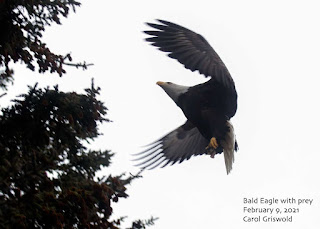Seward, Alaska
Sunrise 8:53 am, sunset 5:34 pm, for a total day length of 8 hours and 41 minutes. Tomorrow will be 5 minutes and 16 seconds longer.
After a sunny but chilly Sunday with temps in the low teens, snow-laden clouds rolled in but few snowflakes sifted down. Actual snowfall measured in inches is forecast for the next several days as temps rise to a high of 30.
The news spread fast and small crowds gathered along the Waterfront around noon: three ORCAS in the bay! The trio swam from the freight dock almost to Lowell Point then returned. One had a smooth, strong dorsal fin, another’s was nicked and gouged. Sadly, the normally tall dorsal fin of the male, which can grow up to six feet high, was flopped over to the left side, completely collapsed, a sign of an injury, age, stress, dehydration, toxin accumulation, or general poor health.
A local whale researcher noted these are definitely transients, frequently seen in the Gulf of Alaska (GOA) area. They are likely hunting for Steller sea lions (often seen lounging by the Uplands/Sheffler Creek area) and harbor seals (also there and scattered around the bay).
The North Gulf Oceanic Society webpage notes: http://www.whalesalaska.org/killer-whales-southern-alaska.htm
GOA (Gulf of Alaska) transients
“The transients in this population, unlike the Chugach transients, are seen infrequently and sporadically in Prince William Sound and more often in Kenai Fjords, usually in the ocean entrances or along the outer coast. Eight of these transients have been genetically sampled.
“All differ in mitochondrial DNA from both the Chugach transients and the West Coast transients of British Columbia and southeastern Alaska.
“It is not uncommon for many years to pass between sightings of individuals within this group, although some matrilines are seen more frequently. The detailed habits and range of these whales are unknown, but the infrequent resightings suggest a large, perhaps offshore range. Their population is not large but seems stable from our recent analysis (Matkin et al 2012).
“From photographs contributed by other mariners and biologists we have tracked many of these whales to the Kodiak archipelago, but none have matched photos of transients from the Aleutian Islands and Bering Sea.
“This supports genetic work that indicates transients in western Alaska are a separate population(s). Tagging data indicates they venture well offshore, at least to the shelf break. Gulf of Alaska transient whales may remain in an area for days or weeks, especially in regions where there are harbor seal or Steller sea lion haulouts. Then they may move on and not be seen again in that area for extended periods; sometimes for years.
“Matushka (AT109), her probable daughter AT111 and the daughter’s offspring AT125 and AT 159, are seen in Hinchinbrook Entrance, Prince William Sound and at the Steller sea lion rookery at the Chiswell Islands, Kenai Fjords.
“In general, the Gulf of Alaska transient killer whales seem to have more nicks or gouges in their dorsal fins than resident killer whales or the Chugach transients. These wounds may result from encounters with Steller sea lions, which are larger and more aggressive than harbor seals or Dalls porpoises.”
I overhead some observers calling them, “Kodiak Killers” a transient group that includes a male, Sasha, AT127 whose fin flopped over in 2005.
Check out this article on another male with a flopped over fin on the left in BC Canada: https://wildwhales.org/2014/07/07/the-case-of-the-flopped-over-fin/
While watching for the whales from Lowell Point Road, I heard a sudden rustling behind me and turned in time to watch an adult BALD EAGLE launch from a nearby spruce tree. It flew purposefully out into the bay over the head of a startled PELAGIC CORMORANT and nabbed something from the water. Then it flew back to its perch. It was difficult to see what it had; just hope it was a fish and not a Marbled Murrelet.
I continued out to Lowell Point Beach to see if the Orcas went around the point. No, but a MEW GULL foraged at the edge of the ebbing tide. A larger immature THAYER’S GULL swooped in, almost on top of it, and took over that particular small stretch of beach. Other than the Gulls, I only saw a few PELAGIC CORMORANTS from the beach.
On Sunday, I watched a HORNED GREBE wrestling with something that looked like a glob of seaweed A closer look revealed a Sculpin with all its spiny fins extended, trying to make itself too large to swallow, fighting for its life. The Horned Grebe persevered and finally got the subdued fish arranged head forward, tail back. I was amazed to see it go down the small Grebe’s throat. It must have felt a bit prickly heading to the stomach!
As for the BRAMBLING, he has been seen in the same neighborhood and often the same yard as before in the alley south of Marathon Drive, sometimes with the 5 or 6 RUSTY BLACKBIRDS and the single female RED-WINGED BLACKBIRD.
The SIBERIAN ACCENTOR has proven more elusive; no reports for about a week. I hope he’s still around.
Happy Birding (and whale watching!)
Carol Griswold
Seward Sporadic Bird Report Reporter






No comments:
Post a Comment